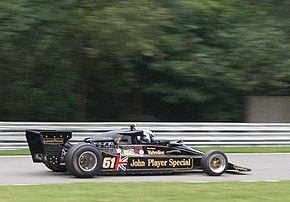Lotus 78
The Lotus 78 was a Formula 1 racing car built by the British racing team Lotus , which was used in the 1977 and 1978 world championships.
The Lotus 78 marked a turning point in the construction of monoposto racing cars. The car, which Colin Chapman laid out in its basic features, was the first true wing car in Formula 1 history and groundbreaking for many racing cars that were subsequently built according to this concept . The aerodynamicist Peter Wright used the negative ground effect when designing the 78 .
Structurally, this was achieved by means of air ducts that are shaped inside the side pods as a negative wing profile (shown in the picture on the left). The principle corresponds to a Venturi nozzle (picture on the right), which is formed between the wing profile and the racetrack. When entering the channel, the flow velocity is comparatively low and the air pressure is high.
The further the air is pushed in the direction of the largest profile thickness of the wing, the more it is accelerated and the air pressure decreases more and more. After the air has passed the point of the smallest distance between the wing and the runway, i.e. the point of the greatest possible negative pressure, the situation is reversed. The diameter of the Venturi tube increases, the air can expand again and loses speed, which is accompanied by an increase in air pressure.
This effect significantly increased the pressure of the vehicle on the road. In addition, strips or aprons made of hard rubber were attached to the side of the chassis on the roadway, sealing the space between the underbody of the vehicle and the roadway in order to further enhance the effect. This construction gave the Lotus 78 three times more contact pressure while maintaining the same air resistance. Ralph Bellamy and Martin Ogilvie were responsible for the monocoque and chose an aluminum composite construction. The body was slim and had wide side panels for the radiator and fuel tank. The tried and tested V8 unit from Cosworth was used as the drive .
The car made its debut at the Argentine Grand Prix with Mario Andretti and Gunnar Nilsson at the wheel. The Lotus 78 was the fastest car of the season. At the fourth start, the US West Grand Prix , Andretti drove the 78 to victory. But three other successes were too few to prevent the constant Niki Lauda from winning the second world championship. In addition to the victories in Spain and Italy , Andretti also won the race in France , where he was able to intercept the long-leading John Watson in the Brabham BT45 on the last lap.
The Swede Nilsson won the Belgian Grand Prix , his first and only Grand Prix victory. Nilsson's compatriot Ronnie Peterson had an accident in Monza in 1978 after a mass collision at the start in a Lotus 78 and died of complications after the subsequent operation. That same year, Peterson won the South African Grand Prix with a 78th place.
In 1978 the 78 was replaced by the Lotus 79 .
literature
- David Hodges: Racing cars from A – Z after 1945. Motorbuch-Verlag, Stuttgart 1994, ISBN 3-613-01477-7 .
- Heinz Prüller : Grand Prix Story 77th Ferrari addio. Orac et al., Vienna et al. 1977, ISBN 3-85368-835-7 .



